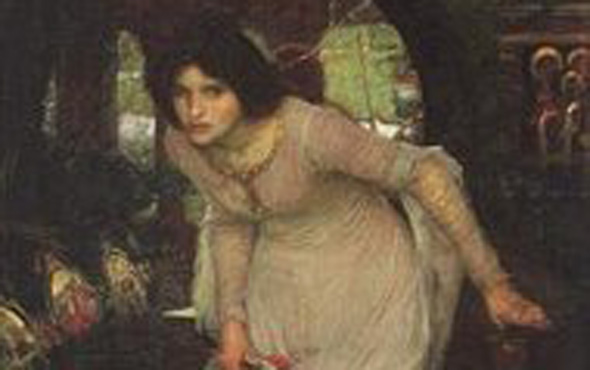John William Waterhouse, the Pre-Raphaelite painter, was inspired by three scenes in Tennyson’s ‘The Lady of Shalott’: the moment at the end of part II when she decides she cannot live with shadows any longer, the minutes following her decision to look out the window, and her trip down the river toward Camelot. In this blog I will focus on the part of the poem that inspired Waterhouse’s I am half sick of shadows, said the Lady of Shalott (1916).
The story of ‘The Lady of Shalott’ will be familiar to many. She lives in a tower outside Camelot and has been forbidden to look out the window. Instead, she must watch the mirrored image of life carrying on without her. As she watches, she must weave the images, or shadows, she sees in the mirror. The people below sometimes hear her sing and call her ‘the Fairy / Lady of Shalott’ (lines 35-36).
". . . half sick of shadows"
The climax of the poem occurs when she sees ‘two young lovers lately wed’ (line 70). This sight causes her to exclaim, ‘“I am half sick of shadows”’ (line 71). Hallam quoted his father’s interpretation of these lines in his Memoir: ‘the new-born love for something, for someone in the wide world from which she has been so long secluded, takes her out of the region of shadows, into that of realities’ (Memoir, i. pages 116-117; quoted in Oxford, Major Works, page 559). In other words, before she notices the lovers, though she is lonely the Lady of Shalott is reasonably content to spend her days weaving the scenes she sees reflected in the mirror. But when she sees the sees the happiness of new love, she needs reality, not shadows.
A Claustrophobic Image
In Waterhouse’s painting of this scene the Lady’s forlorn expression coupled with her posture, she is seated with her hands behind her head, suggest she has surrendered to her fate. The composition of the image is claustrophobic; she almost seems to be trapped between her chair and the loom. The sense of claustrophobia is heightened by the nearness of the mirror to her left—at the bottom of the reflection of the window you’ll see a reflection of the loom, confirming that it is a reflection, not a window. Also, the room is cluttered with balls of yarn on the chequered floor. Of course, richness of detail is a trait we’ve come to associate with the Pre-Raphaelites, but here the detail is restricting rather than luxurious. There is no space in this painting, which makes it easier to understand that she must break free even if death is the price of freedom.
My next blog will focus on the part of the poem that inspired Waterhouse’s The Lady of Shalott (1894).